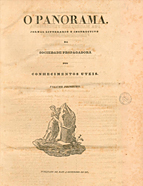

................................
Despite its longevity, O Panorama appears to have suffered a decline in quality after 1844, as suggested by José Silvestre Ribeiro: "In 1857, when the 3rd series of O Panorama was still being published, it was said: 'This periodical is today only an echo of what it used to be. It survives in the shadows of public esteem and the intellectual credit it earned and set as a standard, which the memory of well-read men will respect for a long time to come'" ( História dos Estabelecimentos Científicos... [History of Scientific Establishments], Book 8, p. 26). This assessment is, of course, debatable, because although it no longer had the consistent contributions from names like Alexandre Herculano, Feliciano Castilho, and José Félix Henrique Nogueira, or artists such as Rafael Bordallo Pinheiro, O Panorama continued to bring together prominent figures from Portuguese culture, such as Luís Augusto Rebelo da Silva, Inácio Vilhena Barbosa, and Francisco Gomes de Amorim, António Pedro Lopes de Mendonça, Silvestre Ribeiro himself, Camilo Castelo Branco, Manuel Pinheiro Chagas, among many others. Perhaps more significant, however, are the changes that were beginning to emerge in Portuguese society and the national literary market during its time. As early as 1838, Alexandre Herculano provided a relevant critique of the periodical press, highlighting the Revista Literária do Porto [Porto Literaty Magazine], as the first example of a new genre taking shape. In his view—based on the evolution of the press across Europe—he predicted that the popular newspaper model, like O Panorama , would either fade away or transform into a magazine once its mission of disseminating knowledge was fulfilled. While the popular newspaper model was distinct from the scientific and literary magazines of the 18th century (though retaining some of their characteristics), the literary magazines of the 19th century began to merge these two forms. This reflected societal changes that had occurred—or were anticipated to occur—in Portugal ( O Panorama , Issue 76, p. 326, 1838). One might question whether the newspaper model represented by O Panorama truly disappeared or merely evolved ( Alexandre Herculano. Jornalista , p. 64). Nevertheless, from the 1860s onwards, the national literary market shifted to favour newer formats, such as illustrated magazines. Publications like O Ocidente [The West], 1878-1914) exemplified this trend, placing greater emphasis on images and embracing a more playful and recreational approach (S. C. Matos, Historiografia e memória nacional no Portugal do séc. XIX [Historiography and National Memory in 19th Century Portugal], pp. 146-147). Interestingly, these characteristics were not entirely absent from O Panorama .
This work is financed by national funds through FCT - Foundation for Science and Technology, I.P, in the scope of the projects UIDB/04311/2020 and UIDP/04311/2020.
